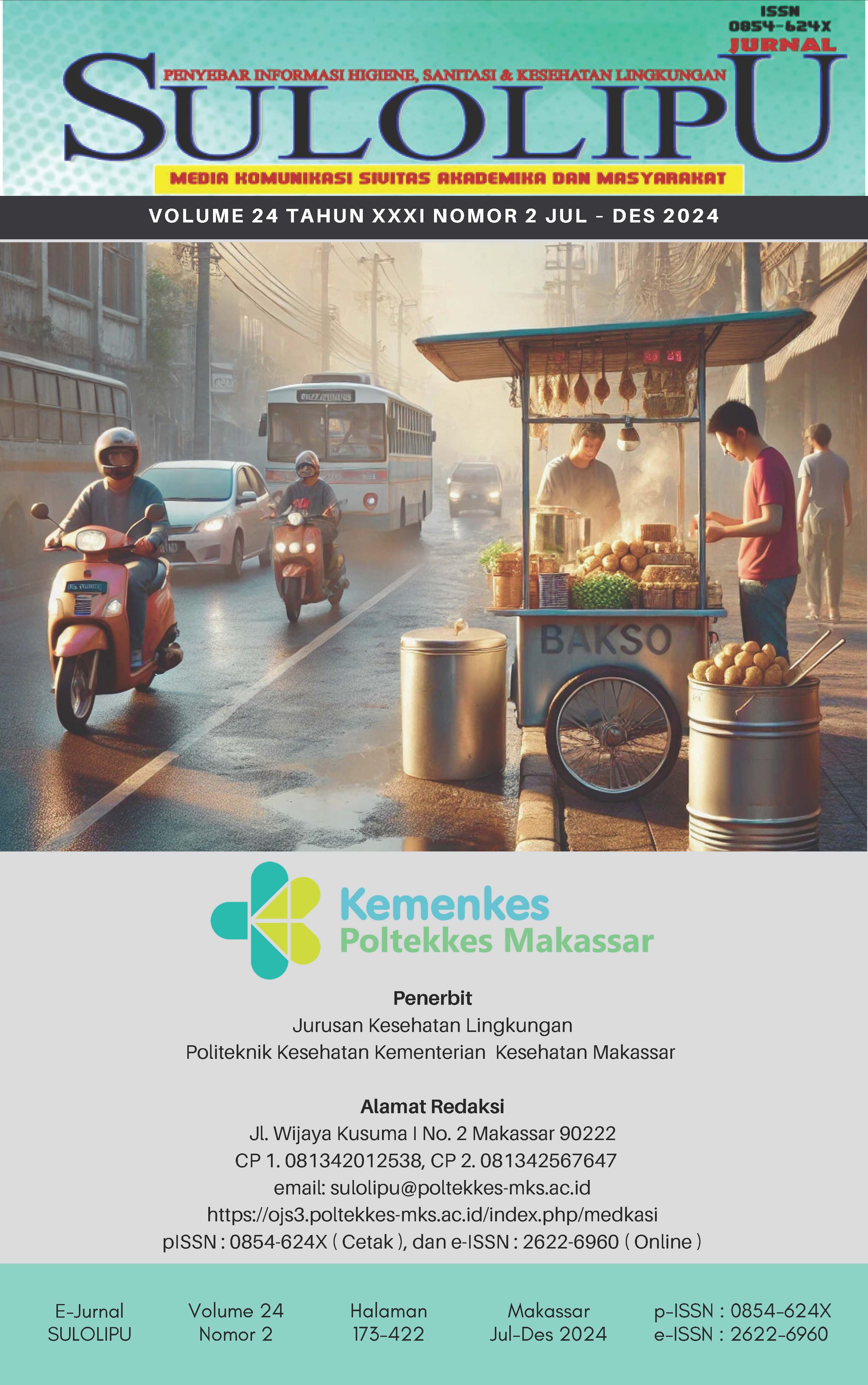Innovative Development of Website-Based Fatigue Measurement System for Construction Industry Workers
DOI:
https://doi.org/10.32382/sulo.v24i2.846Keywords:
Kata kunci : Kelelahan; Pekerja Industri Konstruksi; Website;Kelelahan KerjaAbstract
Construction workers, who work in physically and mentally demanding environments, experience high levels of fatigue, which is a major cause of accidents and occupational illnesses. Therefore, real-time measurement of fatigue is critical to managing the safety and health of construction workers. This study presents an innovative approach to measuring both subjective and objective fatigue through an integrated web-based system using reaction timer technology as a responsive digital measurement tool. The system has been developed using a flexible open source platform (WordPress) with the integration of specialized plug-ins for the automatic collection and analysis of fatigue data. The research method consists of two stages: (1) the development of an integrated fatigue measurement system for construction workers, and (2) a validation study to assess the feasibility of this method by comparing it with traditional methods such as reaction timers and KAUPK2 questionnaires, together with feedback from construction workers in the field (N=60). Participants were divided into three groups: the website group (N=20), the reaction timer group (N=20), and the questionnaire group (N=20). Results: Based on standardized measurements, participants were classified into three fatigue groups: high (6.67%), moderate (70%) and low (23.33%) across all measurement methods. Quantitative results showed statistically significant differences between the three types of fatigue measurement groups. Conclusions: This study highlights the advantages of the web-based system, which is accessible in real time and facilitates the continuous monitoring of fatigue at work. This innovation has the potential to improve the safety management of construction workers through the collection of relevant data and the integration of digital technology, which can be further developed in future research.
Keywords: Fatigue; Construction Industry Workers; Website; Work Fatigue Measurement
References
Agustin, A., Ihsan, T. and Lestari, R. A. (2021) ‘Gambaran Faktor-Faktor yang Mempengaruhi Kelelahan Kerja Pada Pekerja Industri Tekstil di Indonesia: Review’, Jurnal Keselamatan Kesehatan Kerja dan Lingkungan, 2(2), pp. 138–151. doi: 10.25077/jk3l.2.2.138-151.2021.
Ardiansyah, M. I. (2017) ‘Rancang Bangun Reaction Timer Dengan Keypad dan Penyimpan Data’, Integrated Lab Journal, 05(02), pp. 73–80.
Ardiansyah, M. K., Irawan, S. and Purba, H. H. (2022) ‘Identifikasi Faktor Risiko Keselamatan Pada Proyek Konstruksi Bangunan Gedung di Indonesia dalam 10 Tahun Terakhir (2011-2021): Kajian Literatur’, Jurnal Teknologi dan Manajemen, 20(1), pp. 45–58. doi: 10.52330/jtm.v20i1.46.
Artana, I. B., Darmawan, B. and Budiman, D. F. (2020) Pengembangan Alat Uji Kelelahan Fisik Pekerja Berdasarkan Waktu Reaksi Berbasis Arduino Uno. Universitas Mataram. Available at: https://perpus.ft.unram.ac.id/index.php?p=fstream&fid=1836&bid=8542.
Band, R. et al. (2017) ‘Activity patterns in response to symptoms in patients being treated for chronic fatigue syndrome: An experience sampling methodology study’, Health Psychology, 36(3), pp. 264–269. doi: 10.1037/hea0000422.
Behrens, M. et al. (2023) ‘Fatigue and Human Performance: An Updated Framework’, Sports Medicine, 53(1), pp. 7–31. doi: 10.1007/s40279-022-01748-2.
Beno, J., Silen, A. . and Yanti, M. (2022) Analisa Faktor yang Mempengaruhi Tingkat Kelelahan Kerja Pada Pekerja Bagian Produksi di PT. Cipta Baja Raya, Skripsi. Universitas Islam Negeri Medan.
Engelen, L. et al. (2016) ‘Application of ecological momentary assessment in workplace health evaluation’, Health Promotion Journal of Australia, 27(3), pp. 259–263. doi: 10.1071/HE16043.
Eriņš, M. et al. (2019) ‘Research of human fatigue and measurement parameters for workability assessment’, Vide. Tehnologija. Resursi - Environment, Technology, Resources, 2, pp. 38–43. doi: 10.17770/etr2019vol2.4148.
Hedaputri, D. S., Indradi, R. and Illahika, A. P. (2021) ‘Kajian Literatur: Hubungan Tingkat Pengetahuan Kesehatan dan Keselamatan Kerja (K3) dengan Kejadian Kecelakaan Kerja’, CoMPHI Journal: Community Medicine and Public Health of Indonesia Journal, 2(1), pp. 185–193. doi: 10.37148/comphijournal.v2i1.27.
Johanis, A. R. M. et al. (2024) Pengantar Teknologi Digital: Web dan Mobile Teknologi. 1st edn. Edited by A. Karim. Makassar: Yayasan Kita Menulis. Available at: https://www.researchgate.net/publication/381291236_Pengantar_Teknologi_Digital_Web_dan_Mobile_Teknologi.
Kim, H. et al. (2019) ‘Depression prediction by using ecological momentary assessment, actiwatch data, and machine learning: Observational study on older adults living alone’, JMIR mHealth and uHealth, 7(10), pp. 1–24. doi: 10.2196/14149.
Kurniawan, H. et al. (2023) Belajar Web Programming: Referensi Pengenalan Dasar Tahapan Belajar Pemrograman Web Untuk Pemula. 1st edn. Edited by Efitra and Sepriano. Kota Jambi: PT. Sonpedia Publishing Indonesia. Available at: https://books.google.co.id/books?id=gs3OEAAAQBAJ.
Lestari, I. D., Chirzun, A. and Nurhasanah, N. (2023) ‘Analisis Kelelahan Kerja Menggunakan Fatigue Assessment Scale pada PT. Indonesia Power Priok POMU’, Metris: Jurnal Sains dan Teknologi, 23(02), pp. 100–107. doi: 10.25170/metris.v23i02.3897.
Novianti, K. D. P., Putri, N. K. W. L. and Purnamayanti, I. A. G. W. (2022) ‘Analisis Penerimaan Sistem Informasi Menggunakan Technology Acceptance Model (Studi Kasus: SIJALAK Desa Pohsanten)’, INSERT : Information System and Emerging Technology Journal, 2(2), pp. 113–125. doi: 10.23887/insert.v2i2.43135.
Powell, R. I. and Copping, A. G. (2016) ‘Measuring fatigue-related impairment in the workplace’, Journal of Engineering, Design and Technology, 14(3), pp. 507–525. doi: 10.1108/JEDT-09-2014-0063.
Putrisani, F. S., Nugraha, A. E. and Herwanto, D. (2023) ‘Analisis Kelelahan Kerja Subjektif dengan Menggunakan Kuesioner Subjective Self Rating Test’, STRING (Satuan Tulisan Riset dan Inovasi Teknologi), 7(3), p. 258. doi: 10.30998/string.v7i3.14485.
Seong, S. et al. (2022) ‘Development of an integrated fatigue measurement system for construction workers: a feasibility study’, BMC Public Health, 22(1), pp. 1–12. doi: 10.1186/s12889-022-13973-5.
Setiawan, R. A., Pradana, F. and Bachtiar, F. A. (2021) ‘Pengembangan Aplikasi Pendeteksi Kelelahan bagi Pengendara Mobil berbasis Android melalui Face Recognition’, Jurnal Pengembangan Teknologi Informasi dan Ilmu Komputer, 5(11), pp. 5163–5172. Available at: http://j-ptiik.ub.ac.id.
Sumardiyono, Chafiidhiya Rochmah, S. and Seviana Rinawati (2023) ‘Faktor-Faktor yang Berhubungan dengan Kelelahan Kerja Pada Pekerja Penyapu Jalan di Kota Surakarta’, Journal of Applied Agriculture, Health, and Technology, 2(1), pp. 34–42. doi: 10.20961/jaht.v2i1.594.
Techera, U. et al. (2018) ‘Measuring and Predicting Fatigue in Construction: Empirical Field Study’, Journal of Construction Engineering and Management, 144(8), pp. 1–9. doi: 10.1061/(asce)co.1943-7862.0001513.
Widayanti, T. (2021) ‘Use of Google Form in Support of Data Collection for Student Scientific Work’, Judimas, 1(1), p. 85. doi: 10.30700/jm.v1i1.1015.
Zuraida, R. and Chie, H. H. (2014) ‘Pengujian Skala Pengukuran Kelelahan (SPK) pada Responden di Indonesia’, ComTech: Computer, Mathematics and Engineering Applications, 5(2), p. 1012.
Downloads
Published
How to Cite
Issue
Section
PDF (Bahasa Indonesia) downloaded: 640



















